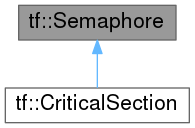 |
Taskflow
3.2.0-Master-Branch
|
 |
Taskflow
3.2.0-Master-Branch
|
class to create a semophore object for building a concurrency constraint More...
#include <semaphore.hpp>

Public Member Functions | |
| Semaphore (size_t max_workers) | |
| constructs a semaphore with the given counter | |
| size_t | count () const |
| queries the counter value (not thread-safe during the run) | |
Friends | |
| class | Node |
class to create a semophore object for building a concurrency constraint
A semaphore creates a constraint that limits the maximum concurrency, i.e., the number of workers, in a set of tasks. You can let a task acquire/release one or multiple semaphores before/after executing its work. A task can acquire and release a semaphore, or just acquire or just release it. A tf::Semaphore object starts with an initial count. As long as that count is above 0, tasks can acquire the semaphore and do their work. If the count is 0 or less, a task trying to acquire the semaphore will not run but goes to a waiting list of that semaphore. When the semaphore is released by another task, it reschedules all tasks on that waiting list.
The above example creates five tasks with no dependencies between them. Under normal circumstances, the five tasks would be executed concurrently. However, this example has a semaphore with initial count 1, and all tasks need to acquire that semaphore before running and release that semaphore after they are done. This arrangement limits the number of concurrently running tasks to only one.
|
inlineexplicit |
constructs a semaphore with the given counter
A semaphore creates a constraint that limits the maximum concurrency, i.e., the number of workers, in a set of tasks.